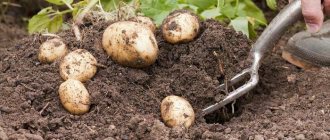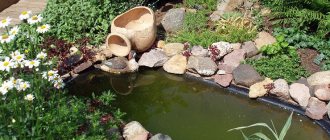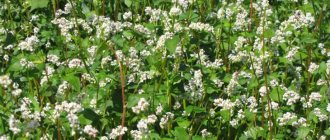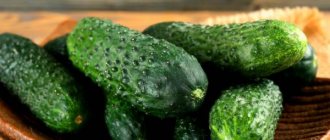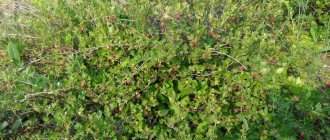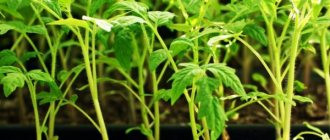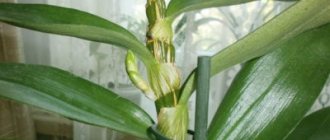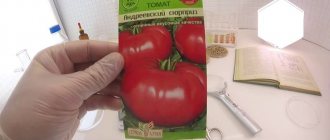Acidic soils: what to do
First you need to determine what type of soil is on the site. To determine this, you will need litmus paper or a special device - a PH meter. Unfortunately, not all summer residents own such a device. Many novice gardeners want to learn how to determine the acidity of the soil on their own using folk remedies. There are several methods.
The easiest way is to brew a mixture of currant and cherry leaves. Place a few leaves in a small container and add boiling water. When the broth has cooled a little, put a small lump of soil in it. If the broth turns red, it means the soil is acidic. Staining blue indicates a neutral reaction.
The method of determining soil acidity by weeds is very productive. There are indicator plants that will help you do this. Dandelion, horse sorrel, plantain, and horsetail grow in large quantities on acidic soil.
You can check the acid level by looking at the beets growing in the area. If the plant has green tops with reddish veins, the soil is slightly acidic; if the plant has red tops, the soil is strongly acidic. Pure green tops occur in beets that grow on neutral soil.
Soil acidity for different crops
For different garden crops, soil acidity may differ. For example, the optimal soil acidity for raspberries is pH 5.8 - 6.2. Raspberry bushes will die in acidic soil, but blueberries prefer soil with an index of less than 5 units. To understand whether the soil needs to be deoxidized or acidified, you can use the table.
Determination of acidity level and timing
At home, the analysis can be carried out at any time from the beginning of spring to the end of autumn, when there is no frost and you can take a soil sample from the site for measurement. No complicated devices are required.
Using litmus paper
To determine acidity, therefore, you need litmus paper, which can be purchased at a pharmacy or store that sells chemical reagents. On its packaging there is a scale, the color of which indicates the level of acidity: from red (acidic pH) through yellow (neutral pH) to blue (alkaline pH). Necessary actions:
- Take 1 tsp in different parts of the garden. land.
- Prepare several portions of solutions with distilled (boiled) water 1:1, mix.
- Dip the paper into all the solutions.
- A litmus stain will accurately indicate the acidity level of that area.
Red color indicates acidic soil, yellow indicates neutral soil, green indicates alkaline soil (very rare).
You may be interested in:
Tilling the soil in the fall from diseases and pests Autumn is not only harvesting, closing conservation, but also preparing the soil for next year. To get…Read more…
Determining acidity using vinegar
Regular 9% vinegar will do. Sprinkle some earth on the glass and drip vinegar. If a reaction occurs with the release of carbon dioxide in the form of bubbles, then the earth is alkaline. If there is a small amount of gas released, the soil is considered alkaline, and if there is no reaction, the soil on the site is acidic and needs to be adjusted.
Using grape juice
Place 1 tsp in a glass of juice. land from the site. If there is a change in color or a reaction in the form of the release of bubbles, then the soil in the area is neutral, if there are no changes, the soil is acidic.
With the help of plants
A number of weeds will help you understand that there is excessive acidity in the area. These include:
- horsetail;
- mint;
- moss;
- woodlice;
- horse sorrel.
If these plants are found in a garden plot, measures must be taken to reduce acidity.
Attention!
Plants that like to grow in acidic soils are called acedophiles.
How to increase soil acidity
Soil acidity needs to be increased if the pH level is 5 or higher. To increase acidity, simple methods are used, for example, adding high peat to the soil. You can spill the soil with acidified water. In a 10 liter bucket of water, dilute 2 tablespoons of citric or oxalic acid. Malic or acetic acid (9%) is suitable. This acid will require 100 ml per 10 liters of water.
If the soil acidity is about 4 units, sulfur is used. Take about 70 g of the substance and apply it per square meter of soil. You can limit yourself to adding peat to the garden soil when planting. Sawdust acidifies the soil well. They are scattered during planting and sometimes used as mulch. Sawdust takes a long time to decompose and acidifies the soil throughout the season.
To slightly acidify the soil, add compost or humus. If you add about 9 kg of compost or 3 kg of humus per square meter of area, the acidity of the soil increases by 1 unit. The acidification procedure must be carried out regularly, as the soil changes its acidity.
How does acidity affect plants?
Soil acidity is characterized by the pH value - an indicator of the level of hydrogen ions. Depending on this value, the reaction of the soil solution can be as follows:
| Reaction | pH |
| Strongly acidic | 3,5-4,0 |
| Sour | 4,0-5,0 |
| Slightly acidic | 5,0-6,0 |
| Neutral | 6,0-7,0 |
| Alkaline | 7,0-8,0 |
High acidity is extremely undesirable. In such an environment, beneficial microorganisms stop actively working. Because of this, the fertility and efficiency of applied fertilizers decreases. Aluminum and manganese accumulate in such soils, which prevent:
- absorption of nutrients;
- normal course of metabolic processes;
- formation of reproductive organs (inflorescences).
As a result, crops develop worse and yields are significantly reduced. Plants lose the opportunity to receive adequate nutrition, and signs of nitrogen starvation appear:
- pale color and thinning leaves;
- shrinking of flowers and fruits;
- increased susceptibility to disease.
Particularly sensitive to aluminum:
- turnip;
- beet;
- peas;
- beans.
Almost all cultivated plants are suitable for manganese.
How to reduce soil acidity
You can deoxidize the soil in different ways. The following substances are used for this:
- dolomite flour;
- slaked lime;
- drywall;
- chalk;
- ash;
- green manure plants;
- complex deoxidizers.
Some gardeners deoxidize the soil with cement. Its components are suitable for these purposes. Old cement, which has already lost its properties for construction, can be used instead of chalk or limestone. For 1 sq. meter will require 1-1.5 kg of this substance. But it is not recommended to get carried away with excessive addition of cement to the soil. Otherwise, manganese, boron and phosphoric acid from the applied fertilizers will become unavailable to plants.
Deoxidizing agents
Soil deoxidation is carried out by various means. To determine the best way to treat an area, you need to focus on the basic properties, availability on the market, as well as the time of the event - different deoxidizers are used for spring and autumn.
Lime
Lime is the most common deoxidizing agent. The following types are suitable for gardening use:
- slaked (fluff);
- key (tuff);
- carbonic acid (ground);
- lake (drywall).
It is impossible to say definitely what kind of lime is needed to deoxidize the soil in a particular area. All of these types have similar properties, but differ in application rates. Slaked and carbonated lime are most often used in the following proportions:
Related article:
We use eggshells as fertilizer for the garden
| Type of lime | Soil acidity level g/sq. m | ||
| weak | average | high | |
| Cancelled | 200 | 300 | 500 |
| Carbon dioxide, including: | |||
| for heavy loam | 300–400 | 450–500 | 550–600 |
| for light loam and sandy loam | 200 | 250–300 | 350–400 |
If these standards are observed, the earth will be deoxidized to a depth of no more than 20 cm. To deepen the effect, the dosage is increased in appropriate proportions. When applying 500 g/sq.m. m or more, repeated liming can be carried out only after 3 years.
Since after applying lime the absorption of phosphorus by plants is disrupted for some time, it is recommended to carry out such treatment in the fall. Before alkalizing the soil, the area must be cleared of all plant residues and debris, and after the event, it must be dug up. By spring, the chemical composition of the soil will return to normal.
Dolomite flour
Dolomite flour (ground dolomite into powder) has distinct advantages over lime. This substance is less aggressive and absolutely safe in terms of environmental cleanliness, therefore it is suitable for autumn and spring application for planting or digging.
Related article:
8 Low Sugar Fruits and Berries
When purchasing, you should choose dolomite flour with a minimum (up to 0.25 mm) fraction size - the smaller they are, the more effective the action will be. The humidity level should not exceed 1.5%.
The application rates for such a substance will be as follows:
- at low acidity – 300–400 g/sq.m. m;
- at average – 400 g/sq.m. m;
- at high – 500 g/sq.m. m.
Dolomite is especially useful for normalizing the acidity of such a valuable substrate as peat. To deoxidize peat with dolomite flour, the drug is added in an amount of 300 g/sq.m. m.
In any case, dolomite flour will not only reduce the acid reaction, but also have a number of other beneficial effects:
- saturate the bed with magnesium, calcium, and other micro- and macroelements;
- normalize its general formula and structure;
- loosen the soil, especially viscous clay soil;
- destroy infections, fungi, pests (including mole crickets and Colorado potato beetles).
Dolomite powder is specially applied before mineral fertilizers to improve their digestibility.
Ash
Wood ash is another effective deoxidizer that combines the properties of organic and mineral fertilizer. But it is quite difficult to talk about the specific qualities of this substance, since ash can be very different depending on many characteristics of the wood from which it is obtained.
Related article:
How to stack and store firewood: 5 tips for stacking and caring for firewood for a summer house
If we consider only alkalizing properties, then the following application rates give a good result:
- wood ash – 1–1.5 kg/sq. m;
- grass ash – 2.5–3 kg/sq. m.
Also, ash is often used not in its own form, but as an addition to the main liming in two ways:
- as an additive to substances with a very active effect (most often lime, but also chalk and gypsum to prevent salinization);
- for re-treatment the next year after increased alkalization of the area (at the rate of 200 g/1 l for treatment of 1 sq. m).
But much more often, ash is still used as fertilizer. It is usually applied to holes or furrows when planting various crops.
Read the article about applying ash as fertilizer.
Chalk
Many gardeners have doubts as to whether it is possible to use and, if so, how to apply chalk for deoxidation, so as not to deteriorate the composition of the soil. This attitude is due to the fact that with frequent use of this substance there is a high probability of salinization of the bed.
Related article:
Garden pest control calendar
In addition, many are not sure whether chalk deoxidizes the soil at all, because its effect is very mild and short-lived. For this reason, such a deoxidizer should be added every year, and this is definitely fraught with the above-mentioned salinization.
To avoid all these problems, you need to alternate chalk with other described deoxidizing substances. The combination with lime is especially useful, the aggressive action of which does not allow it to be applied to the site more often than once every 3 years.
Chalk is added to the soil during digging in the fall and spring. You can also scatter the powder at the end of winter on the snow, when it melts the chalk penetrates deep into the ground.
Application rates should be as follows:
- with weak acidity – 200–300 g/sq.m. m;
- at average – 400 g/sq.m. m;
- with strong – 600 g/sq.m. m.
Use chalk only when ground to a powder, and when embedding it is thoroughly mixed with the soil.
Related article:
How to prepare your garden for the new season
Gypsum
For those who still doubt whether it is possible to carry out deoxidation with chalk, it is recommended to ensure that the soil is deoxidized with gypsum. Its advantage is that after application it dissolves in the soil not with water, but only with an acidic environment. That is, while the soil is acidic, gypsum reacts and deoxidizes it, and as soon as the pH value returns to normal, it ceases its effect. Moreover, it remains in the ground until acid appears in it again, after which it neutralizes it again.
Gypsum is added in the following quantities:
- in slightly acidic soil – 100–200 g/sq.m. m;
- medium acidified – 300 g/sq.m. m;
- with high acidity – 400 g/sq.m. m.
However, it should be borne in mind that gypsum also contains a lot of calcium, which can lead to soil salinization.
Soda
There are 4 types of soda - baking soda, soda ash, crystalline and caustic. At the same time, calcined and crystalline are very aggressive and require caution, and caustic is not used for processing the garden due to its chemical composition. Therefore, soil deoxidation is usually carried out with baking soda. But due to its weak alkaline reaction, it is only suitable for treating soils with low acidity.
Related article:
How to grow mushrooms in your garden
Soda is used in the form of an aqueous solution. At the same time, its maximum concentration should not exceed 15%, and the application rate should not exceed 5 l/sq.m. m. Exceeding the specified dosages can cause a sharp increase in the amount of sodium, which reduces the nutritional value of the soil and harms yields.
Complex drugs
A good and more reliable alternative to all of these remedies are ready-made complex preparations, which are not only guaranteed to have a deoxidizing effect, but also supply the main useful elements - phosphorus, magnesium, calcium, copper and others. When choosing a complex, you should pay attention to the following parameters:
- composition, which should contain the substances necessary for a specific area;
- fraction size - the smaller they are, the better;
- environmental cleanliness and safety.
Each complex soil deoxidizer has its own instructions for use. But most often, preparations of similar action are applied during autumn digging with uniform distribution over the surface and subsequent watering. The effect after such application usually lasts for 2 years.
Related article:
What fruit and berry crops are recommended for planting on 6 acres
Green manure plants
Before using a soil deoxidizer, you can try planting green manure, which is very common in organic farming and definitely will not harm the garden. In terms of effectiveness, this method is similar to liming, but it does not have the aggressive effect characteristic of lime and does not pose a risk of oversaturating the area with calcium. Green manure can be sown in spring or autumn.
Good to know: Dates for autumn planting of green manure
In addition to the deoxidizing effect, they have many more advantages:
- are high-quality organic (green) fertilizer;
- improve soil composition, including nitrogen saturation;
- increase its air and moisture permeability;
- suppress the growth of weeds;
- fight pests.
Green manures such as phacelia, alfalfa, oats, rapeseed, rye, wheat, and buckwheat cope best with all these functions. When sowing in autumn, they are mowed and then dug up or left on the surface as mulching material.
How to deoxidize the soil with dolomite flour
Dolomite flour is a powder made from crushed rock.
This substance reduces acidity levels and improves the structure of the top layer of soil. Flour is sold in its pure form without impurities or additives. Soil deoxidation is possible in spring and autumn. How much dolomite flour to add? The application rates of dolomite flour to deoxidize the soil depend on the soil acidity indicators:
- For medium acidic soil - 45 kg/100 sq. m.
- For strongly acidic (up to pH4.5) - 50 kg/100 sq. m.
- For slightly acidic conditions - 35 kg/100 sq. m.
The type of soil also affects flour consumption. On heavy soil, loams and clays, the amount of fertilizer increases by 20%, and on sandy soils it is reduced by 1.5 times.
It is considered best to apply dolomite flour before applying mineral fertilizers. She interacts with them organically.
If the soil is intended for growing vegetables, dolomite flour is applied half a month before planting. This will prevent infection of crops with fungal diseases. The addition of dolomite flour improves the properties of the soil in greenhouse conditions.
Why is soil deoxidation necessary?
Increased soil acidity is a problem that should not be ignored. Such a substrate is an excellent medium for the proliferation of pathogenic microorganisms and viruses. Weeds and mosses thrive in it.
But cultural plantings love slightly acidic, neutral soil. In soil with a low pH, their development slows down, and the plantings themselves weaken and become susceptible to pests and infections.
Soil deoxidation is the only effective way to bring the pH to an acceptable level. The frequency of the procedure depends on the characteristics of the substrate:
- Loams: after 7 years.
- Sandy soils: once every 5 years.
- Peat substrates: after 3 years.
The amount of funds applied depends on the percentage of humus in the soil. The higher it is, the more money you need to spend.
Is the soil always deoxidized?
If you find that the pH of the substrate in your garden is low, do not try to neutralize its entire area. Check if there are plantings that like moderately acidic soil:
- Berries: lingonberries, strawberries, cranberries, blueberries.
- Vegetables: turnips, potatoes, carrots, sorrel, radish, pumpkin, tomatoes.
- Ornamental plants: azalea, fern, hydrangea, chicory, conifers.
But fruit bushes and trees develop in such an environment and bear fruit very sparingly - they need neutral soil.
How to deoxidize the soil in the fall
It is more advisable to deoxidize the soil with lime in the fall. Over the winter, a neutralization reaction will occur in the soil. The following types of mineral additives are used for liming:
- Slaked lime, or fluff. You can get it yourself by slaking ordinary lime with water. Fluffweed neutralizes acidic soil.
- Crushed limestone. The optimal and affordable option. Magnesium carbonate is usually added to this mixture.
Limestone for deoxidation is applied locally throughout the entire area or in a specific bed. If you cannot apply lime in the fall, you need to use other types of fertilizer. How to calculate the consumption rate? To deoxidize sandy loam and sandy soil by 10 square meters. meters contribute a kilogram of limestone. To deoxidize loamy and clayey soils, you need to increase the amount three times.
The fertilizer rate also depends on the depth to which the fertilizer is applied. The consumption rate increases if the lime is laid to a depth of about 20 cm. If the consumption of limestone is more than 500 g per square meter, the deoxidation process must be planned for three years.
How to determine if the soil is acidic
With increased acidity of the soil, plants do not absorb some of the nutrients from it. To reap a good harvest, you need to pay attention to the condition of the soil. If acidity is high, weeds such as dandelion, horse sorrel, and horsetail usually grow in large quantities in such areas.
You can determine the acidity of the soil using indicator strips. There are equally reliable folk methods. For example, you can take a tablespoon of earth and pour a small amount of 9% vinegar on it. If the soil is alkaline, a lot of foam will form. Neutral soil does not give such a violent reaction. If the soil is acidic, there will be no foam at all.
How to deoxidize the soil in the garden with chalk
Chalk is a substance of natural origin that is very often used to deoxidize soil in the garden. It reduces high acidity, acting gently on the soil. It needs to be applied to the dacha every year, not necessarily before winter. In the spring, a month before the planned date of planting, chalk is evenly scattered over the surface of the territory. Then they start digging. It is effective to use chalk in early spring on snow. It will melt, and meltwater will carry grains of chalk deep into the soil. It is not recommended to apply chalk too much or too often, as it accumulates in the soil, causing salinization.
Soil types
Soils suitable for agriculture are distinguished by type:
- Clay soils are soils containing at least 40% pure clay. Typically sticky, damp, viscous, heavy and cold. But they contain quite a lot of nutrients. Such soils slowly absorb water and do not pass it well into the lower layers. Plants planted on them rarely suffer from lack of moisture. Main disadvantages: very difficult to process, turn to stone and crack when dry, become limp in wet weather.
- Sandy - crumbly, containing about 50 times more sand than clay. They absorb well, but do not retain water well. Nutrients are also washed out of them with water. These soils warm up very quickly, but also cool down.
- Sandy loam – those where the ratio of sand and clay is 7:3. They are crumbly, retain moisture well, and are favorable for plant growth.
- Loams - contain more than 70% clay. There are light, medium and heavy. Rich in nutrients and minerals. These are breathable and easy to cultivate soils.
- Podzolic soils are soils formed in areas where coniferous forests grow. They have high acidity and poor fertility.
- Peat - formed under the influence of constant strong waterlogging. They conduct heat poorly and warm up slowly. They have high acidity.
- Chernozems are the most fertile soils. They are distinguished by their dark color and high humus content.
Deoxidation of soil with ash
Ash is an effective soil deacidifier, but not the best. It is better to use ash on soil that requires slight deoxidation. To influence the acidity level to a greater extent, it is necessary to add a lot of ash, and this will lead to the accumulation of too many microelements in the soil. It is safe to say that ash is more of a feeding agent than a deoxidizing agent.
In the event that ash still needs to be used, you should give preference to ash from birch wood. It contains a large amount of phosphorus and potassium. Its norm per square meter is about 10 kg.
Use of industrial drugs
To deoxidize the soil, you can use ready-made deoxidizer preparations available in gardening stores. Industrial products have a complex effect - they not only normalize the acid-base balance of the soil, but also additionally saturate it with valuable nutrients.
Humatized soil deoxidizer is a preparation based on humates and calcites. It lowers the acid level and at the same time increases soil fertility. Such deoxidizers are produced by several manufacturers. The dosage and method of use of the drug is indicated in the instructions - a special drug that is a highly effective deoxidizer and organic-mineral fertilizer. This product contains lime, a significant portion of boron, magnesium, nitrogen, phosphorus and potassium, as well as humates. The drug helps to neutralize the soil reaction, since obtaining a bountiful harvest is possible only on neutral or slightly acidic soil.
Soil deoxidation is an effective agrotechnical procedure that is carried out in the fall, after harvesting. It helps to normalize the acid-base balance of the soil, increase its fertility, ensure active growth of cultivated plants and maximum absorption of applied fertilizers.
Application of green manure plants
Those gardeners who prefer organic farming use green manure plants to deoxidize the soil. There is no need to worry about excess calcium and calculate application rates. The use of this method, subject to the rules of crop rotation, allows you to do without the use of dolomite, limestone and other mineral fertilizers.
Phacelia has proven itself well for reducing soil acidity. The plant is also an excellent honey plant, attracting a large number of pollinating insects to the site. Phacelia is planted in the spring; it has a beneficial effect on the soil throughout the growing season; by autumn you can already feel that the acidity of the soil has decreased. Before frost, the plant is mowed and embedded in the soil. Other equally effective green manure plants are: rye, alfalfa, white mustard, and sweet clover.
Is it always necessary to reduce acidity?
If there are plants growing on the site that need acidic soil for a comfortable existence, then soil deoxidation is carried out in separate areas or not at all. Grows well in soil with low pH:
- sorrel;
- rhubarb;
- blueberry;
- mint;
- fern;
- rhododendrons.
Most vegetables grow well in slightly acidic or neutral soils rich in nutrients. But too frequent liming leads to excess calcium in the soil, as a result of which the root system of plants is inhibited. Therefore, in the spring, experienced gardeners recommend checking the pH of the soil in the area and basing further measures on this indicator.
Attention!
The reason for soil acidification is the displacement of calcium by hydrogen ions from compounds in the soil.
Frequency of deoxidation procedure
How often is deoxidation performed? This depends on many factors, the main one being the level of acidity. Strongly acidic soils need to be deoxidized every four years. Basic deoxidation on slightly acidic soils is carried out every five to eight years.
Every year it is necessary to carry out activities aimed at maintaining neutral acidity. You can limit yourself to adding a small amount of dolomite flour before planting crops; this will help neutralize the acidic soil. In specialized stores you can find a large number of special mineral complexes that are designed to regulate soil pH levels. They are enriched with various microelements; in most cases they are additionally used as a top dressing.
All of the above methods of soil deoxidation can be combined or alternated with each other. In the spring, manure and dolomite flour are added to a shallow depth during digging. Then spill with a solution of Baikal-EM1. This is a biological product that contains special soil bacteria that accelerate the decomposition process. 2 weeks after treatment, sowing of green manure begins.
Soils and fertilizers
To choose the right fertilizer for the soil, you need to consider:
- soil type;
- season;
- weather.
The same fertilizer may be perfect for a site in the spring, but turn out to be harmful in the fall.
Solid and poorly soluble mixtures are convenient to use in wet weather - nutrients will not be washed out too quickly by rain. But they will be completely useless during a drought.
How to fertilize clay soil
The main task of fertilizing loam is to make it suitable for planting cultivated plants. This means: increase breathability and reduce moisture. Therefore, before you start fertilizing clay soil with mineral fertilizers, you need to add organic matter to it. During initial processing, you will need at least one and a half buckets per square meter.
On clay soil, manure continues to act for up to 8 years. On lighter soils – only 4 years.
In the future it is useful to use the mixture:
- manure – 10 kg;
- potassium nitrate – 100 g;
- sawdust 2 kg.
Sawdust can be soaked in a urea solution - about 100 g per bucket of water.
A good autumn fertilizer for clay soil will be green manure from legumes. They are sown at the beginning of summer, and dug up at the end, without waiting for flowering. You can simply cut the greens with a flat cutter and lightly mix them with the top layer of soil.
Sand is used as a fertilizer to loosen soil that is too dense. It is also applied in the fall, along with organic matter. For every square meter you will need at least three buckets of sand.
Before applying mineral fertilizers, the acidity of the soil should be determined. To do this, just take a closer look at the vegetation. Plantain, woodlice and horsetail grow best in acidic soil. On the neutral side you can often see clover, chamomile and bindweed.
Deoxidation and basic fertilizers
Deoxidation can have a negative impact on the amount of nutrients, so it must be carried out competently, observing the recommended timing and consumption rates.
If you add too much lime to the soil, potassium, manganese, iron, and boron will turn into compounds that are not absorbed by plants. Cultures begin to suffer from their lack. When using nitrogen-phosphorus fertilizers and deoxidizers together, unpleasant consequences are also observed: plants stop absorbing phosphorus and nitrogen, which affects their growth. To prevent this from happening, it is necessary to carry out deoxidation in the fall, and apply nutritious fertilizers in the spring. Then they will not interfere with each other. After the main deoxidation has been carried out, it is not recommended to apply mineral fertilizers to the soil for the first two years. You can use organic matter or limit yourself to foliar feeding on the leaf.
What difficulties arise when soil deoxidizes?
If you cannot use the listed products, or they are not effective enough, I advise you to pay attention to special liming compounds in garden centers. Choose complex preparations that simultaneously deoxidize and fertilize. They should include:
- magnesium;
- calcium;
- phosphorus;
- zinc;
- boron;
- manganese;
- copper.
Make sure that the fractions of the drug are small, and that its packaging has a mark on its environmental friendliness and safety of use. Basically, such products are used for autumn digging. Like traditional ones, they are spread evenly over the surface of the earth, and then the area is dug up using the bayonet of a shovel. After this, you need to water the garden bed. The effect of using the product is within 2 years.
At high pH, I advise you to carry out complex treatment:
- In the spring, add manure, dolomite, and do a shallow dig.
- Treat the area with the biological preparation “Baikal” (contains soil bacteria).
- After 2-3 weeks, plant green manure.
In order not to harm the soil and plantings by deoxidation, I recommend the following:
- Follow the timing and dosage.
- Apply lime carefully: its excess makes valuable elements (manganese, boron, potassium, iron) difficult for the root system to absorb.
- Try to deoxidize the soil in the fall and fertilize in the spring.
- After deep liming, refrain from applying mineral fertilizers for two years. Replace them with organic matter or apply foliar feeding.
Before liming the soil in the garden, be sure to determine the pH of the substrate. Don't forget about plants that like moderately acidic soil. Use potent drugs only in case of high acidity; try to replace them with green manure. After all, oversaturation of soil with calcium is no less harmful than its deficiency.
How to test the acidity of the fertile soil layer
You can check the acidity of the soil using litmus paper by dissolving a handful of soil in a glass of distilled water. When the sediment has settled, an indicator should be lowered into the liquid and the state of the soil layer can be determined from the color image: from the orange color of high acidity to the blue color of an alkaline reaction.
Soil acidity: testing
The acidity of the soil layer is indicated by the alphanumeric designation pH, in which numbers less than 6 indicate increased acidity, and numbers greater than 7 indicate an alkaline reaction. Plants develop best with a normal reaction, falling somewhere between the acidic and alkaline states.
Determination of soil pH level.
You can also determine acidic soil by the vegetation that grows on agricultural land:
- Horse sorrel, horsetail, plantain, sow thistle, and reeds growing in masses indicate a medium to high acidity of the area. You should not focus on single plants that can grow in almost any soil;
- chamomile, wheatgrass, clover, radish characterize soil with a slightly acidic reaction;
- coltsfoot, toadflax, bindweed, and field mustard prefer the alkaline reaction of the soil.
A popular way to determine the acidity of the fertile layer is to steam cherry and currant leaves with boiling water. When the infusion has cooled, pour a handful of earth into it. A change in the color of the liquid to red indicates increased acidity.
Chalk
It will be useful to deoxidize the soil in the spring with chalk. This additive is more neutral and is well suited for soil with weak acidity. Chalk grains should be small, no more than 1-2 mm.
The soil is deoxidized according to the following calculations (per square meter):
- sour – 300 g;
- medium sour – 200 g;
- slightly acidic – 100 g.
The ground is sprinkled with chalk, and then the top layer of soil is mixed.
